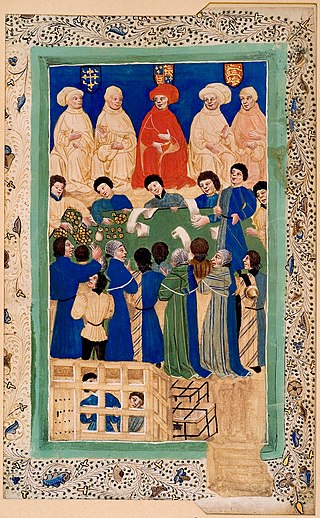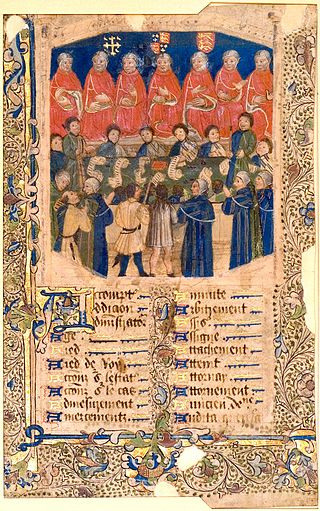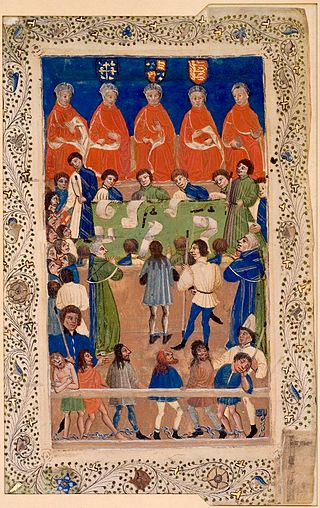
The Court of King's Bench was one of the senior courts of common law in Ireland. It was a mirror of the Court of King's Bench in England. The Lord Chief Justice was the most senior judge in the court, and the second most senior Irish judge under English rule and later when Ireland became part of the United Kingdom. Additionally, for a brief period between 1922 and 1924, the Lord Chief Justice of Ireland was the most senior judge in the Irish Free State.

The Exchequer of Pleas, or Court of Exchequer, was a court that dealt with matters of equity, a set of legal principles based on natural law and common law in England and Wales. Originally part of the curia regis, or King's Council, the Exchequer of Pleas split from the curia in the 1190s to sit as an independent central court. The Court of Chancery's reputation for tardiness and expense resulted in much of its business transferring to the Exchequer. The Exchequer and Chancery, with similar jurisdictions, drew closer together over the years until an argument was made during the 19th century that having two seemingly identical courts was unnecessary. As a result, the Exchequer lost its equity jurisdiction. With the Judicature Acts, the Exchequer was formally dissolved as a judicial body by an Order in Council on 16 December 1880.

The Court for Crown Cases Reserved or Court for Criminal Cases Reserved was an appellate court established in 1848 for criminal cases in England and Wales. to hear references from the trial judge. It did not allow a retrial, only judgment on a point of law. Neither did it create a right to appeal and only a few selected cases were heard every year.

The Court of Common Pleas, or Common Bench, was a common law court in the English legal system that covered "common pleas"; actions between subject and subject, which did not concern the king. Created in the late 12th to early 13th century after splitting from the Exchequer of Pleas, the Common Pleas served as one of the central English courts for around 600 years. Authorised by Magna Carta to sit in a fixed location, the Common Pleas sat in Westminster Hall for its entire existence, joined by the Exchequer of Pleas and Court of King's Bench.

The Court of Chancery was a court which exercised equitable jurisdiction in Ireland until its abolition as part of the reform of the court system in 1877. It was the court in which the Lord Chancellor of Ireland presided. Its final sitting place was at the Four Courts in Dublin, which still stands.

The Court of King's Bench, formally known as The Court of the King Before the King Himself, was a court of common law in the English legal system. Created in the late 12th to early 13th century from the curia regis, the King's Bench initially followed the monarch on his travels. The King's Bench finally joined the Court of Common Pleas and Exchequer of Pleas in Westminster Hall in 1318, making its last travels in 1421. The King's Bench was merged into the High Court of Justice by the Supreme Court of Judicature Act 1873, after which point the King's Bench was a division within the High Court. The King's Bench was staffed by one Chief Justice and usually three Puisne Justices.
Sir Richard Ryves (1643–1693) was a seventeenth-century Irish judge who served for several years as Recorder of Dublin, and subsequently as a Baron of the Exchequer. He was briefly a Commissioner of the Great Seal.
Sir Gerard Lowther (1589–1660), sometimes referred to as Gerald Lowther, was a member of the well-known Lowther family of Westmoreland. He had a distinguished judicial career in Ireland, becoming Chief Justice of the Irish Common Pleas, although his enemies claimed his success was due to a complete lack of moral principles.

The Court of Common Pleas was one of the principal courts of common law in Ireland. It was a mirror image of the equivalent court in England. Common Pleas was one of the four courts of justice which gave the Four Courts in Dublin, which is still in use as a courthouse, its name.

The Court of Exchequer (Ireland), or the Irish Exchequer of Pleas, was one of the senior courts of common law in Ireland. It was the mirror image of the equivalent court in England. The Court of Exchequer was one of the four royal courts of justice which gave their name to the building in Dublin in which they were located, which is still called the Four Courts, and is in use as a courthouse.
The High Court of Justice in Ireland was the court created by the Supreme Court of Judicature Act (Ireland) 1877 to replace the existing court structure in Ireland. Its creation mirrored the reform of the courts of England and Wales five years earlier under the Judicature Acts. The Act created a Supreme Court of Judicature, consisting of a High Court of Justice and a Court of Appeal.
Sir James Dowdall was an Irish judge of the Elizabethan era who briefly held office as Lord Chief Justice of Ireland. He should not be confused with James Dowdall, the Catholic martyr, who was his cousin.
John Keppock was an Irish judge of the late fourteenth century, who held the offices of Lord Chief Justice of Ireland, Chief Baron of the Irish Exchequer and Deputy Lord Chancellor of Ireland. He became a politician of some importance.
Henry Mitchell (c.1320–1384) was an Irish judge of the fourteenth century. He was one of the first recorded holders of the office of Attorney General for Ireland, and was subsequently Chief Baron of the Irish Exchequer and Chief Justice of the Irish Common Pleas.
John Tirel, or Tyrell was a prominent judge and statesman in fourteenth-century Ireland who held office as Serjeant-at-law and Chief Justice of the Irish Common Pleas.
The chief justice of Munster was the senior of the two judges who assisted the Lord President of Munster in judicial matters. Despite his title of Chief Justice, full judicial authority was vested in the lord president, who had "power to hear and determine at his discretion all manner of complaints in any part of the province of Munster", and also had powers to hold commissions of oyer and terminer and gaol delivery.
The chief justice of Connacht was the senior of the judges who assisted the Lord President of Connaught in judicial matters. Despite the chief justice's title, full judicial powers were vested in the Lord President, whose office was established in 1569. Ralph Rokeby was appointed the first chief justice of Connacht, with Robert Dillon as his second justice. Rokeby found his principal duty as chief justice, the introduction of the common law into Connacht, to be a thankless task, writing gloomily to the Government in London that the people of the province "are not willing to embrace justice".
Oliver Jones was an Irish politician and judge of the seventeenth century, who was widely rumoured to have secret Roman Catholic sympathies, and was criticised for changing sides during the English Civil War.
Sir Robert Dillon of Newtown near Trim was an Irish judge of the Tudor era. He served as Chief Justice of the Irish Common Pleas for more than twenty years, despite repeated calls for his removal on the grounds of age and ill health.
Sir William le Deveneys was a Crown administrator and judge in late thirteenth and early fourteenth century Ireland, who served very briefly as Chief Justice of the Irish Common Pleas.





